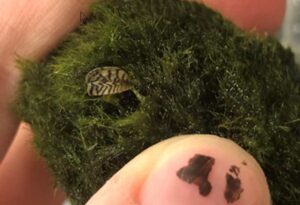Alaskans who purchased marimo moss balls asked to call hotline

(Statewide) – The Alaska Department of Fish and Game (ADF&G) and the Alaska Department of Natural Resources (ADNR) are alerting Alaskans, aquarium owners, and the aquatic pet industry that shipments of marimo moss balls (Aegagrophila linnaei), also commonly called Cladophora balls, contaminated with invasive zebra mussels (Dreissena polymorpha) were improperly shipped to Alaska and a number were sold in pet stores as early as May 2024.
If you have purchased marimo moss balls from a local store or an online retailer, your aquarium could be contaminated with zebra mussels. Please contact the ADF&G invasive species hotline at 1-877-INVASIV (1-877-468-2748) for guidance on disposing of aquarium pets or sanitizing aquariums and aquarium water.
Marimo moss balls are living algae balls which are placed in aquariums and fish tanks as visually appealing additives, or they can be displayed as stand-alone decor. This is not the first time zebra mussels have hitchhiked to Alaska on wild-collected moss balls. This pathway for introduction of aquatic invasive species was initially observed and reported on in 2021. Since then, state laws have been implemented to reduce the chance of these nonnative and invasive organisms causing negative economic or environmental consequences in Alaska waters.
A prohibition on importing, possessing, transporting, buying, selling, or offering for sale any part of an invasive zebra mussels or marimo moss ball became effective in 2021. Zebra mussels and other dreissenid mussels are listed as banned invasive species under ADF&G regulation 5 AAC 41.075 (Classification of banned invasive species), which went into effect April 25, 2021. ADNR established a Marimo and Cladophora Balls exterior quarantine under authority of AS 03.05.010 and AS 03.02.027, effective April 6, 2021; therefore, it is prohibited to import, transport, buy, offer for sale or distribute these aquatic pests. However, it was recently discovered that these moss balls have been imported and then sold in Alaska.
Introduction of aquatic invasive species occurs when unwanted aquarium pets and plants or aquarium water is dumped into Alaska creeks, lakes or other water bodies, or down the drain. Although this is prohibited, we know it occurs based on other invasive organisms reported to ADF&G, such as goldfish, a freshwater ray, and the notoriously invasive aquatic plant Elodea, which is now widespread in parts of Alaska. Juvenile zebra mussels are not visible to the naked eye and could go unobserved in an aquarium. Although it might seem harmless to dump your aquarium water into the nearby pond or down the drain, if zebra mussels are able to grow to adulthood, they will cause harmful problems where they become established. As adults, these fingernail-sized freshwater shellfish with zebra-striped shells, pose a significant threat to Alaska freshwater environments. They destroy food webs, salmon habitat, and cause loss of recreational opportunities. Costly negative economic impacts to fisheries and infrastructure for hydropower and drinking water have occurred in other states where zebra mussels were inadvertently released. Additionally, waterfront homeowners could see property values decline.
ADF&G and ADNR are working together with other states and federal agencies to address this concerning issue and continue to collaborate on aquatic invasive species prevention, management, and control.
For information on how to identity and report invasive species, visit ADF&G’s Invasive Species webpage or contact Tammy Davis:
To learn more about ADNR’s quarantine of moss balls, please follow the link below or contact Mia Kirk:
|
ADNR Contact |
ADF&G Contact |
|
Mia Kirk |
Tammy Davis |
 |
 |
